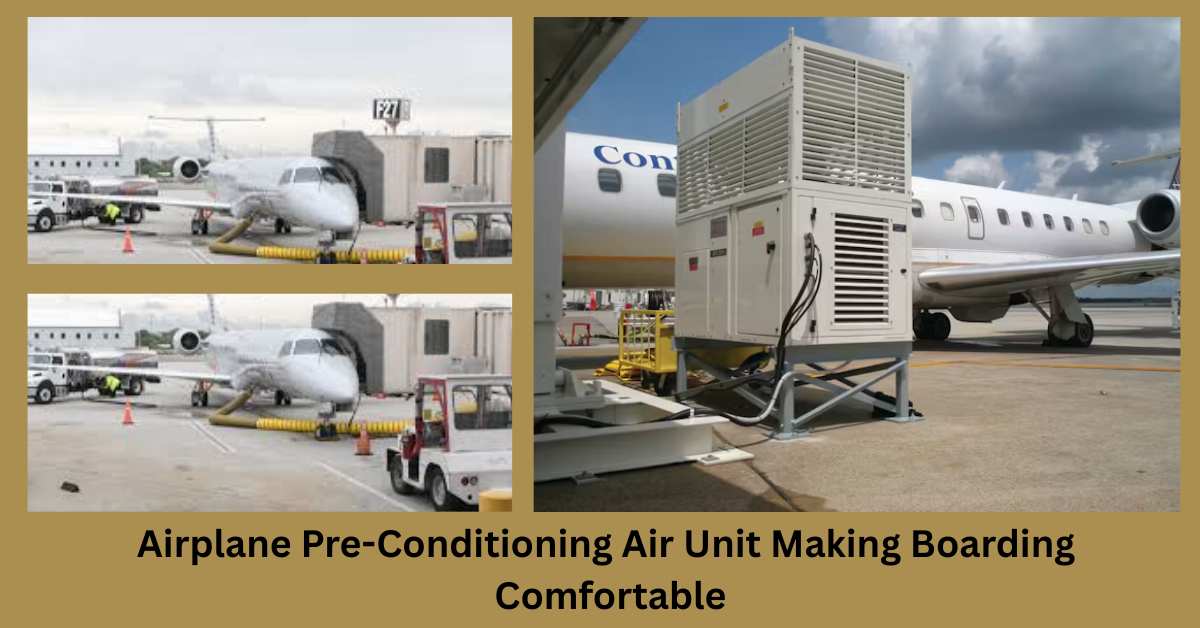Airplane Pre-Conditioning Air Unit is a ground support system designed to deliver cooled or heated air directly into an aircraft’s cabin while it is parked at the gate.
Instead of relying on the plane’s Auxiliary Power Unit (APU) or onboard environmental control systems, the PCA unit connects through an external hose and supplies pre-treated air at the right temperature and humidity.
This process not only keeps passengers and crew comfortable during boarding but also significantly reduces fuel burn, emissions, and operational noise.
Airports and airlines worldwide use PCA units as part of their sustainability and cost-saving strategies, and in many regions, their use is mandated to meet environmental standards.
By maintaining a stable cabin climate before takeoff, PCA systems improve passenger satisfaction, reduce complaints about extreme cabin temperatures, and ensure smoother ground operations. They also extend the life of aircraft systems by minimizing unnecessary APU usage.
Airplane Pre-Conditioning Air Unit Making Boarding Comfortable
In this guide, we will explain how airplane pre-conditioning air unit work, why they are critical for passenger comfort, and what real-world data says about their benefits.

Airplane Pre-Conditioning Air Unit systems offer a clean, energy-efficient way to keep aircraft cabins comfortable before takeoff. Unlike the plane’s on-board Auxiliary Power Unit (APU), which burns jet fuel and generates noise and emissions, PCA units deliver filtered, temperature-controlled air directly into the cabin using ground-based power sources .
1. Setting the Stage: Why Pre-Conditioned Air (PCA) Matters
PCA units matter because they significantly reduce dependency on APUs during boarding. APUs are notoriously fuel-inefficient with only 8–14% efficiency and a major source of CO₂ emissions and ramp noise. Switching to PCA can achieve up to 90% reductions in fuel use and emissions . Moreover, eliminating APU noise improves the boarding experience for both passengers and ground crews.
2. How PCA Works in Simple Terms
A PCA unit functions similarly to a home air conditioner but on a much larger scale. It pulls in fresh air, filters it, adjusts temperature and humidity, then sends it into the parked aircraft via a hose. This process eliminates the need for the plane’s internal air-conditioning packs or APU to run, translating into quieter, cleaner, and more efficient ground operations.
3. Real-World Impact:
- Fuel and Emissions: PCA dramatically cuts fuel burn and pollutants by reducing APU usage.
- Noise: Ramp-level noise drops significantly, improving conditions near the terminal.
- Operational Gains: Using PCA maintains cabin climate well in advance of boarding, minimizing delays and improving on-time performance.
4. Benefits Under the Hood
- Cost Savings: Electric PCA units consume far less energy than running APUs and reduce engine wear.
- Healthier Ramp Environment: By eliminating jet fuel combustion, PCA helps lower air pollution and protect ground personnel and nearby communities.
- Consistent Comfort: PCA delivers stable cabin temperature and humidity during boarding, improving passenger comfort and reducing heat-related complaints.
- Flexibility: PCA units come in electric or engine-driven, and can be fixed, mobile, bridge-mounted, or underground – letting airports choose based on infrastructure and cost priorities.
5. Real Voices: When PCA Isn’t in Use
- Without PCA, boarding cabins can become uncomfortably hot or cold, forcing crews to start engines just to regulate temperature.
- Some reports note long delays restoring comfort – one even cited the use of APU-generated heat to quickly lower temperatures by more than 60°C.
- Airports without PCA at all gates experience higher APU usage, noise, and complaints, especially during extreme weather.
6. How PCA Supports Better Boarding: A Brief Breakdown
| Step | Benefit |
|---|---|
| Connect PCA immediately after docking | Maintains cabin comfort pre-boarding |
| Keep APU off | Quiet, efficient, low emissions |
| Stable cabin climate | More satisfied passengers, fewer delays |
| Operational agility | Energy savings + smoother ground service |
7. Wrap-Up: Strong, Real, and Ready to Go
In straightforward terms-PCA units elevate boarding comfort, cut costs, and support environmental goals. Evidence from airports and technical sources highlights their role in smoothing operations, extending equipment life, and delighting passengers. Airports can choose from modular PCA options to best suit their layout and needs.
Conclusion
In conclusion, the airplane pre-conditioning air unit is more than just a piece of ground equipment it is a key contributor to smoother, more efficient, and more comfortable air travel.
By supplying pre-cooled or pre-heated air directly to the cabin while the aircraft is parked, PCA units minimize the need for fuel-hungry APUs, resulting in substantial cost savings, reduced emissions, and quieter terminal environments. For passengers, this translates into a boarding experience free from extreme temperatures, unpleasant air quality, or noise disruptions.
For airlines and airports, it means extended equipment life, better compliance with environmental regulations, and improved operational efficiency.
As more airports invest in modern PCA infrastructure, the benefits are being felt at every level from the ramp crew to the passengers in their seats.
Consistent climate control before takeoff is not just a comfort feature; it is an operational necessity in today’s competitive and eco-conscious aviation industry.
Simply put, the PCA unit is an essential bridge between ground operations and a comfortable journey in the air.





